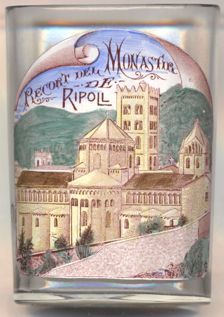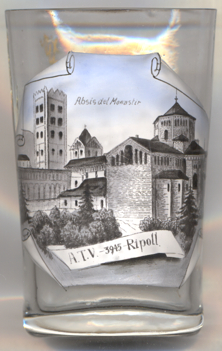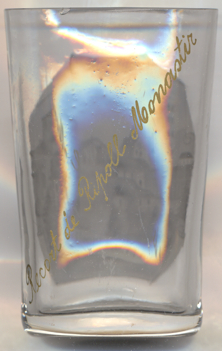

|
| ESPAÑA | Spain |
| Catalunya / Cataluña | Catalonia |
| Provincia: Girona / Gerona | Girona |
Ripoll is situated at an altitude of 691 m at the confluence of the river Ter with its tributary Freser in the Catalan Pre-Pyrenees near the French border. The town, often refered to as the birthplace of Catalonia, is the capital of the Comarca Ripollès; the municipality has a population of about 10,700 (2019).
The earliest evidence of human presence in Ripoll dates to the Bronze Age (1500–600 BC). The area has been used as a crossing point between the central Catalan depression and the other part of the Pyrenees since ancient times. There are indications of occupation during the late Roman or Visigothic period. With the recapture of the territory between Cerdanya and Barcelonès by Count Guifré el Pelòs (Wilfred 'the Hairy', 840–897), where in Ripoll he founded the Catalan nation, the repopulation of the area began in 879 with the foundation of two monasteries: Santa Maria de Ripoll (879) and Sant Joan de les Abadesses (887). In the 14th century, the canal became the economic basis for the population supporting working of iron, fabrics and wood. This time was temporarily interrupted by the earthquake of Catalonia of 1428, which caused serious damages to the monastery and the village. In the 16th century clashes between the monastery and the villagers were frequent and, while not abolishing the bonds that tied the village to the monastery, the power of the abbots was diminished. This situation was aggravated by the involvement in warlike conflicts (Reapers' War, continued presence of the French army in Ripoll, and the War of the Spanish Succession). Througout the 16th to the 18th century, the economy flourished again based on the trades associated with iron working. During the French War (1808–1814) the French occupied Ripoll. In 1812 Ripoll finally gained independence from the power of the abbots, whom they had been subject to since the 9th century. The supremacy of the monastery ended definitely within the framework of the First Carlist War (1833–1840), but it also ended the period of economic flourishing. During the Carlist occupation, the town was set afire. After rebuilding the town, its economy was largey based on the textile sector. The rail connection between Ripoll and France was established by the Trans-Pyrenees railway, opened in 1929. The town grew quickly especially in the second half of the 20th century. Since the end of the dictatorship in 1975, the town has undergone a series of changes aimed at modernisation.
 The
The  Monastery of Santa Maria de Ripoll [left, no. 3979, and below, no. 3826]
was founded in 888 by Count Wilfred the Hairy (Guifré el Pilós in Catalan) who used it as a centre to bring
about the repopulation of the region after conquering it. The monastery grew rapidly, and was subsequently reconsecrated
in 935, 977 and 1032, though the monks are known to have been established there permanently only from 1025 or 1032. The
scriptorium and the monastic school quickly gained renown under Arnold Scholasticus (active in the 11th p;century).
The monastery had several offshoots which included the abbeys of St. Martin-du-Canigou (now in France) and that of
Santa Maria de Montserrat. It was also known for its collection of manuscripts which numbered
246 by the year 1046, and later included the 13th century Gesta comitum Barcinonensium, considered to be the first
history of Catalonia and written by the monks themselves. From 1070 to 1169 the monastery was governed by the Abbey of
St. Victor of Marseille. Santa Maria de Ripoll was the main religious center of Catalonia
until the 15th century, when it started to decline, beginning with the loss of control over the Monastery of Montserrat
in 1402. In 1428 it was severely damaged by an earthquake, after which it was restored with the new parts in Gothic style.
The monastery became the family mausoleum for the Counts of Barcelona and Counts of Besalú, and well as a great
center of learning, with a large library. The library and much of the monastery's vast archives were destroyed by fire in
1835, after it had been secularized. In 1847 part of the cloister was demolished, followed in 1856 by the abbey palace.
It was rebuilt in 1886, the basilica being consecrated in 1896.
Monastery of Santa Maria de Ripoll [left, no. 3979, and below, no. 3826]
was founded in 888 by Count Wilfred the Hairy (Guifré el Pilós in Catalan) who used it as a centre to bring
about the repopulation of the region after conquering it. The monastery grew rapidly, and was subsequently reconsecrated
in 935, 977 and 1032, though the monks are known to have been established there permanently only from 1025 or 1032. The
scriptorium and the monastic school quickly gained renown under Arnold Scholasticus (active in the 11th p;century).
The monastery had several offshoots which included the abbeys of St. Martin-du-Canigou (now in France) and that of
Santa Maria de Montserrat. It was also known for its collection of manuscripts which numbered
246 by the year 1046, and later included the 13th century Gesta comitum Barcinonensium, considered to be the first
history of Catalonia and written by the monks themselves. From 1070 to 1169 the monastery was governed by the Abbey of
St. Victor of Marseille. Santa Maria de Ripoll was the main religious center of Catalonia
until the 15th century, when it started to decline, beginning with the loss of control over the Monastery of Montserrat
in 1402. In 1428 it was severely damaged by an earthquake, after which it was restored with the new parts in Gothic style.
The monastery became the family mausoleum for the Counts of Barcelona and Counts of Besalú, and well as a great
center of learning, with a large library. The library and much of the monastery's vast archives were destroyed by fire in
1835, after it had been secularized. In 1847 part of the cloister was demolished, followed in 1856 by the abbey palace.
It was rebuilt in 1886, the basilica being consecrated in 1896.

 The picture on glass no. 3826 [near left] is based on a postcard by the Barcelona postcard editor
Àngel Toldrà Viazo (1867–1956). Each of his postcards was labeled with his initials 'A.T.V.' and a
number; a total of 4.577 of these are known, mostly depicting urban spaces in Catalonia and the Balearic Islands. The
labelling on the glass, "A.T.V. – 3945", refers to his postcard no. 3945. The picture on
this souvenir glass is of course not a reproduction of the photograph/postcard, but a drawing based on it; the drawing
was reproduced as a transfer print on these souvenir glasses and was then coloured by hand.
The picture on glass no. 3826 [near left] is based on a postcard by the Barcelona postcard editor
Àngel Toldrà Viazo (1867–1956). Each of his postcards was labeled with his initials 'A.T.V.' and a
number; a total of 4.577 of these are known, mostly depicting urban spaces in Catalonia and the Balearic Islands. The
labelling on the glass, "A.T.V. – 3945", refers to his postcard no. 3945. The picture on
this souvenir glass is of course not a reproduction of the photograph/postcard, but a drawing based on it; the drawing
was reproduced as a transfer print on these souvenir glasses and was then coloured by hand.
While the picture on glass no. 8326 [left] is labeled in Castilian Spanish Absis del Monastir
('apse of the monastery'), the back side [right] is labeled in Catalan: Recort de Ripoll Monastir
('souvenir from Ripoll monastery').
[https://de.wikipedia.org/wiki/Ripoll, https://ca.wikipedia.org/wiki/Ripoll, https://en.wikipedia.org/wiki/Ripoll;
https://en.wikipedia.org/wiki/Santa_Maria_de_Ripoll;
https://ca.wikipedia.org/wiki/Àngel_Toldrà_Viazo;
https://www.raco.cat/index.php/AnnalsCER/article/download/204094/289082]
![[scale]](lineal.jpg)